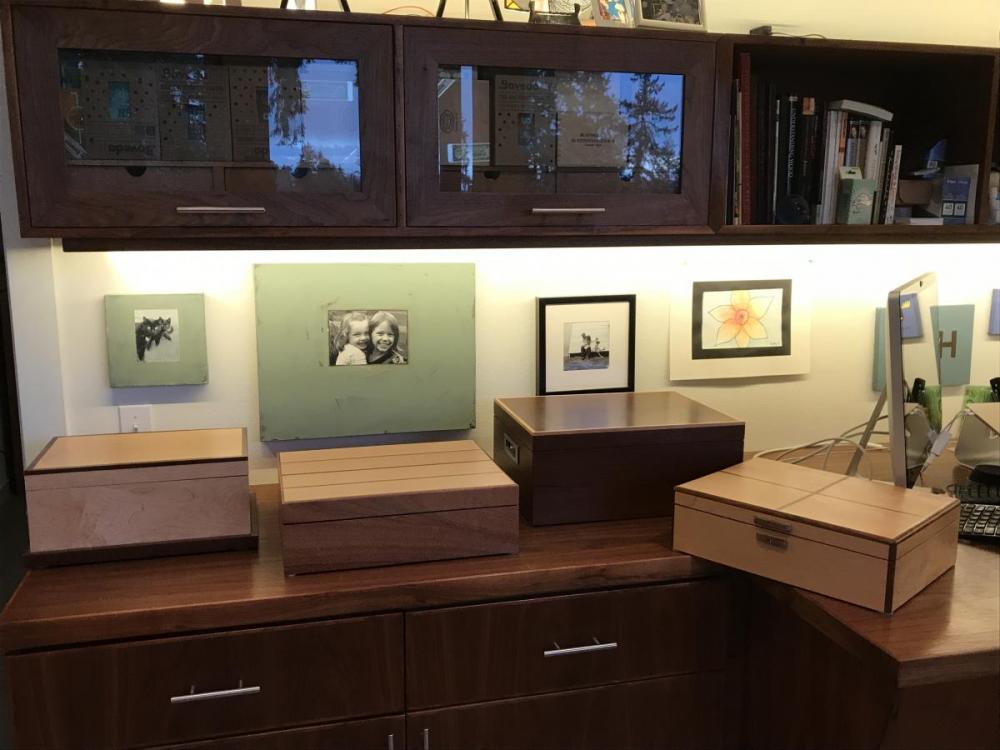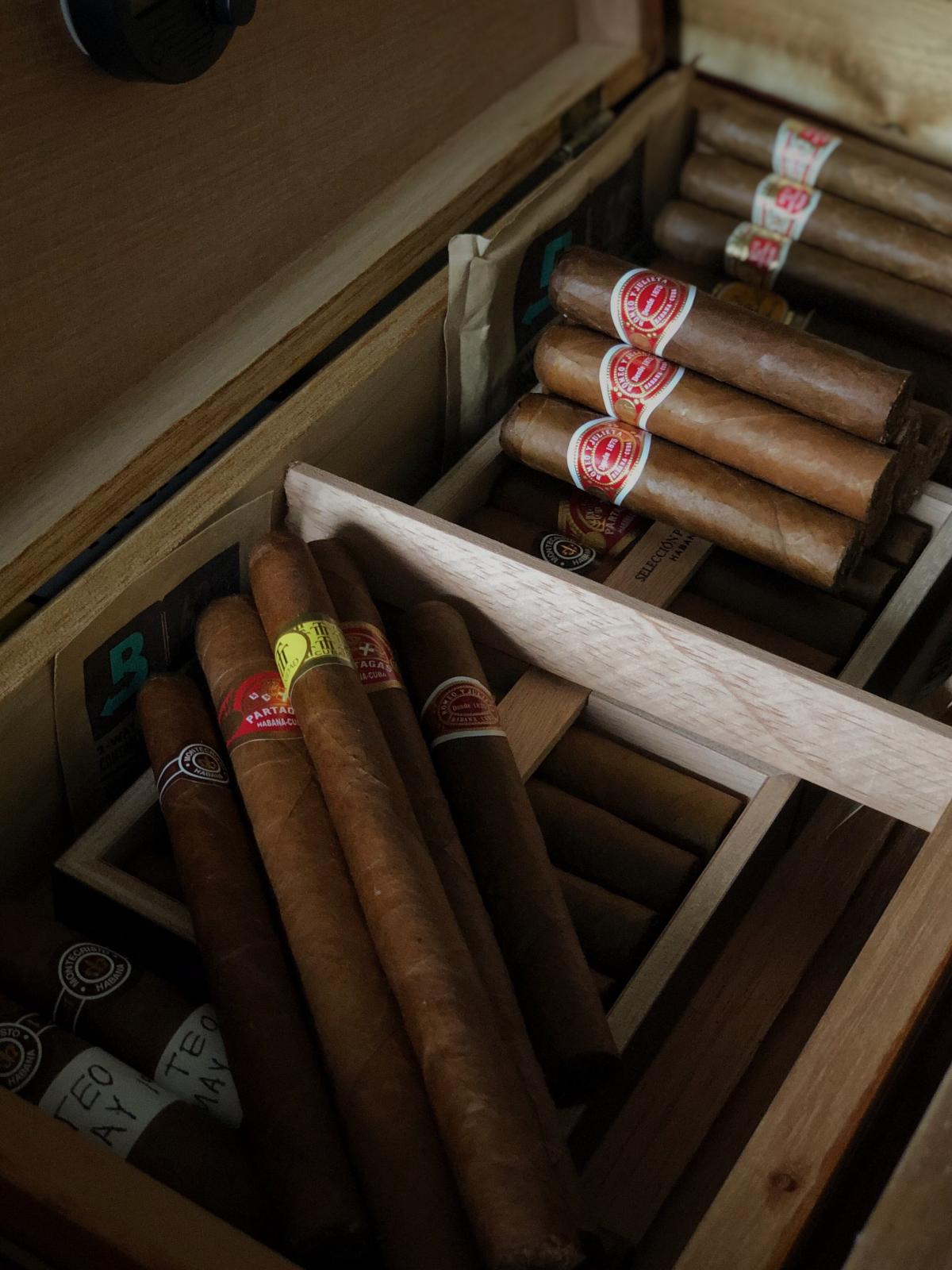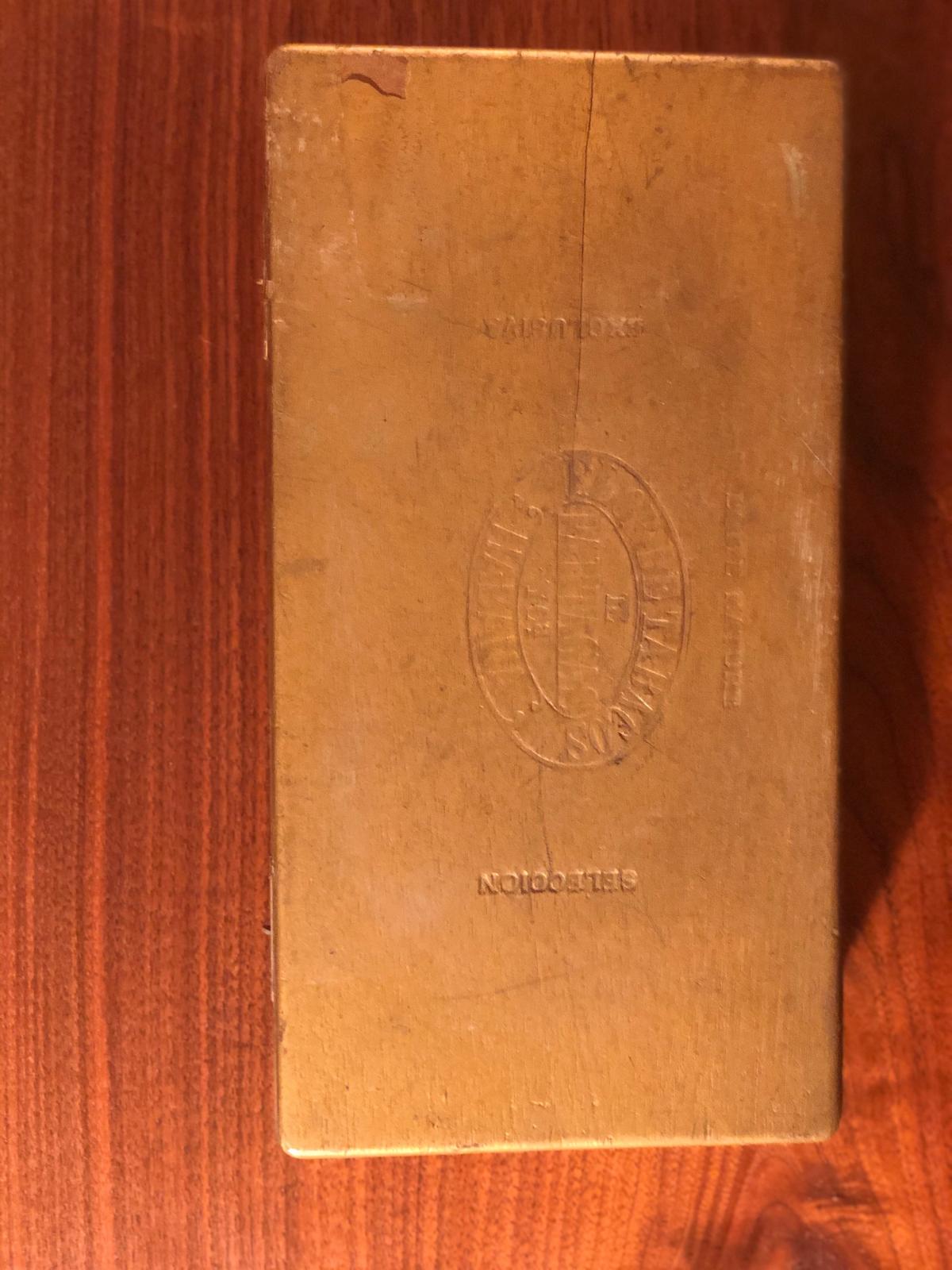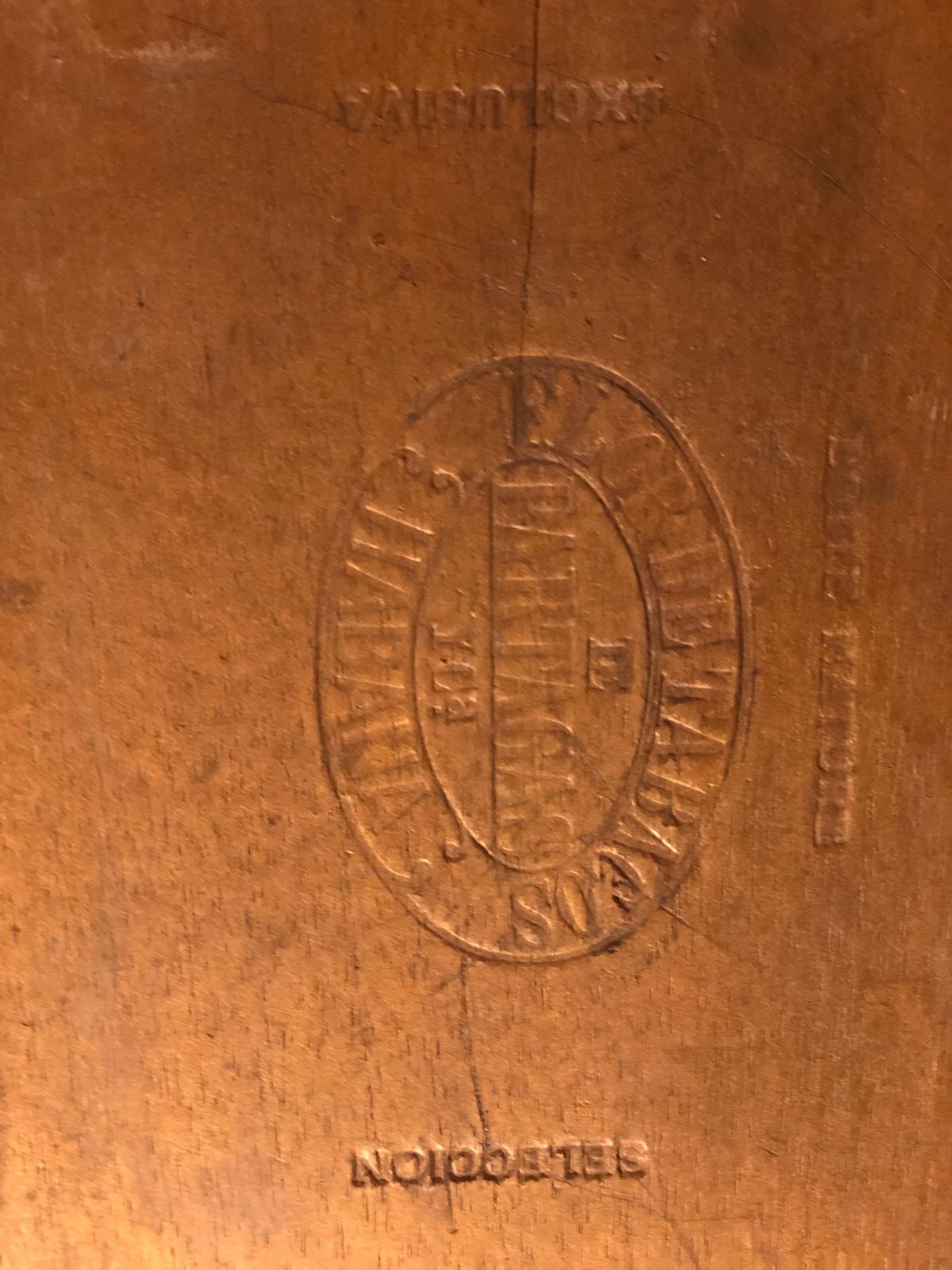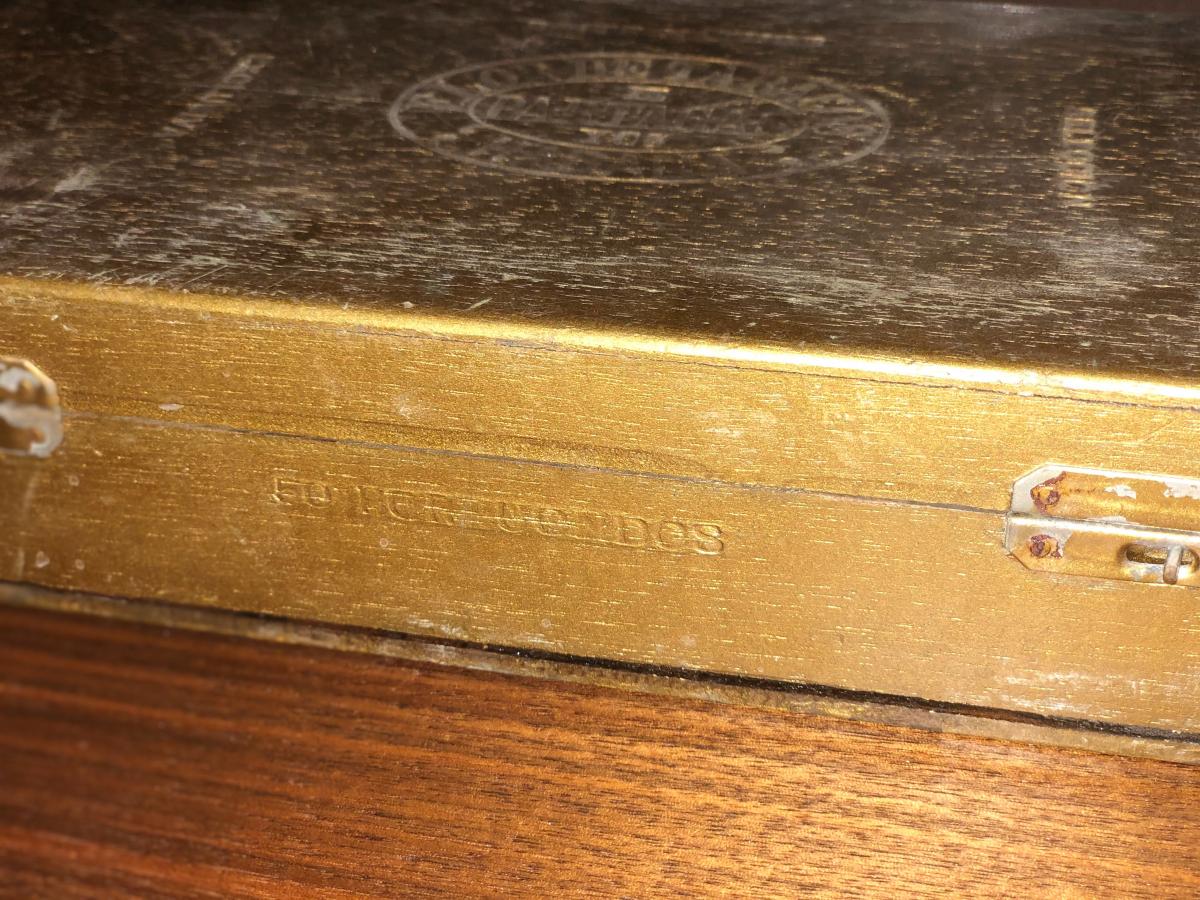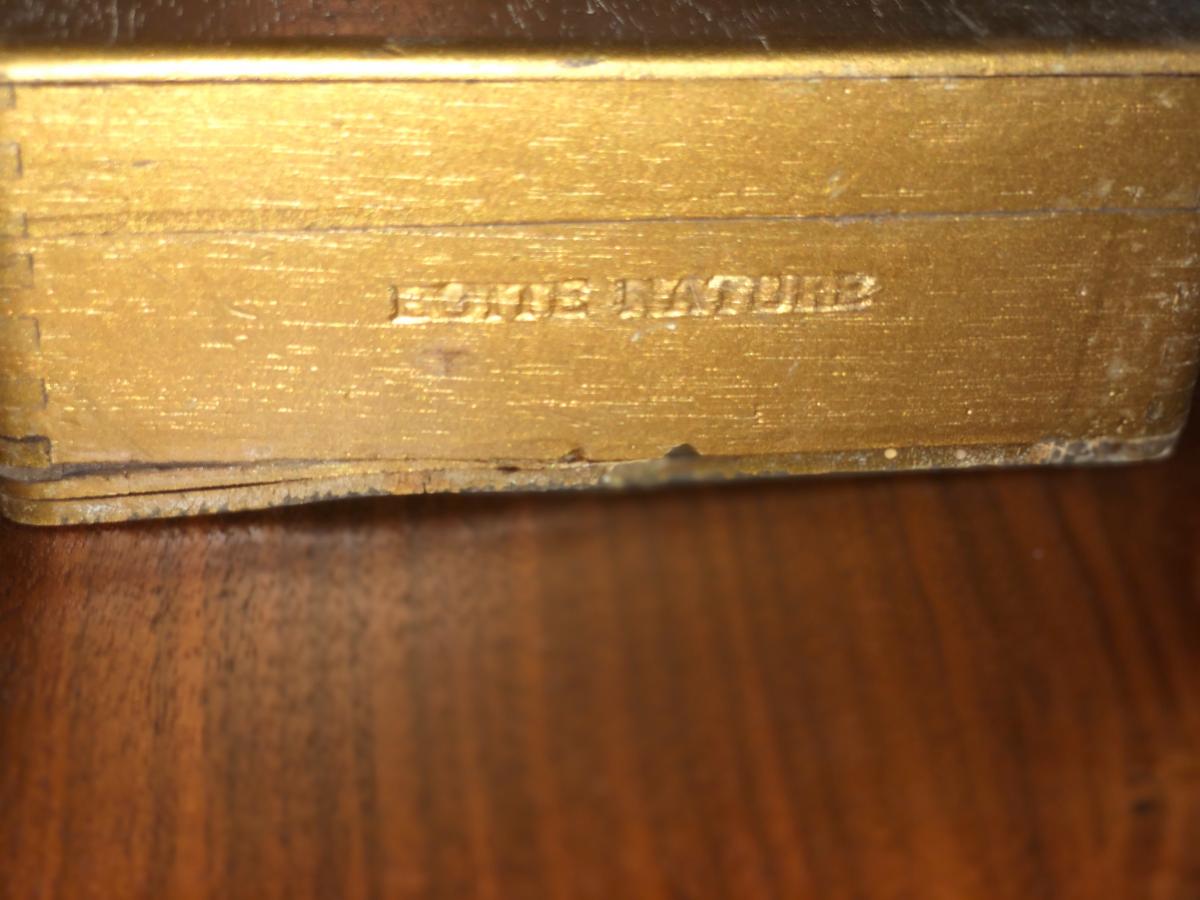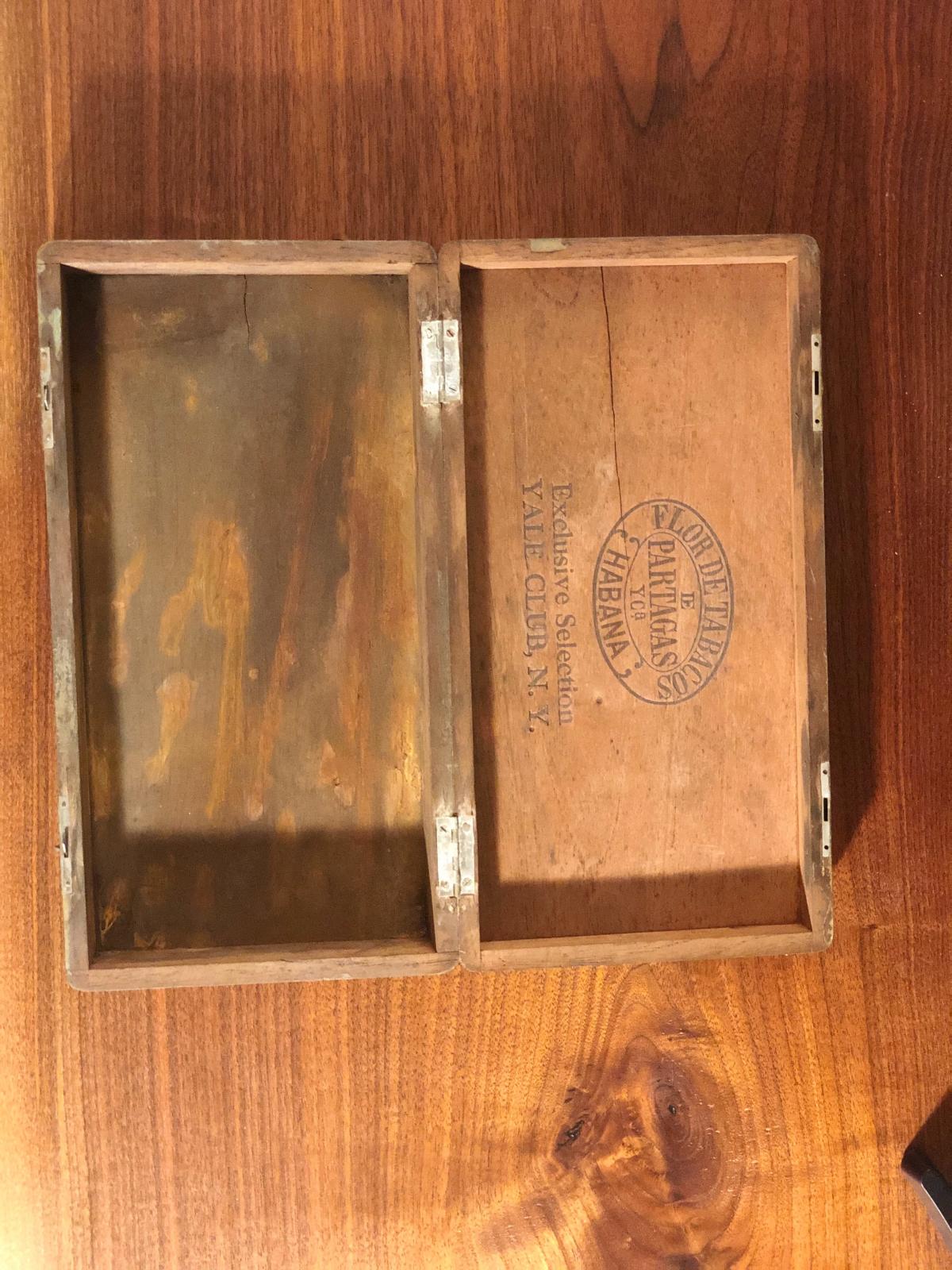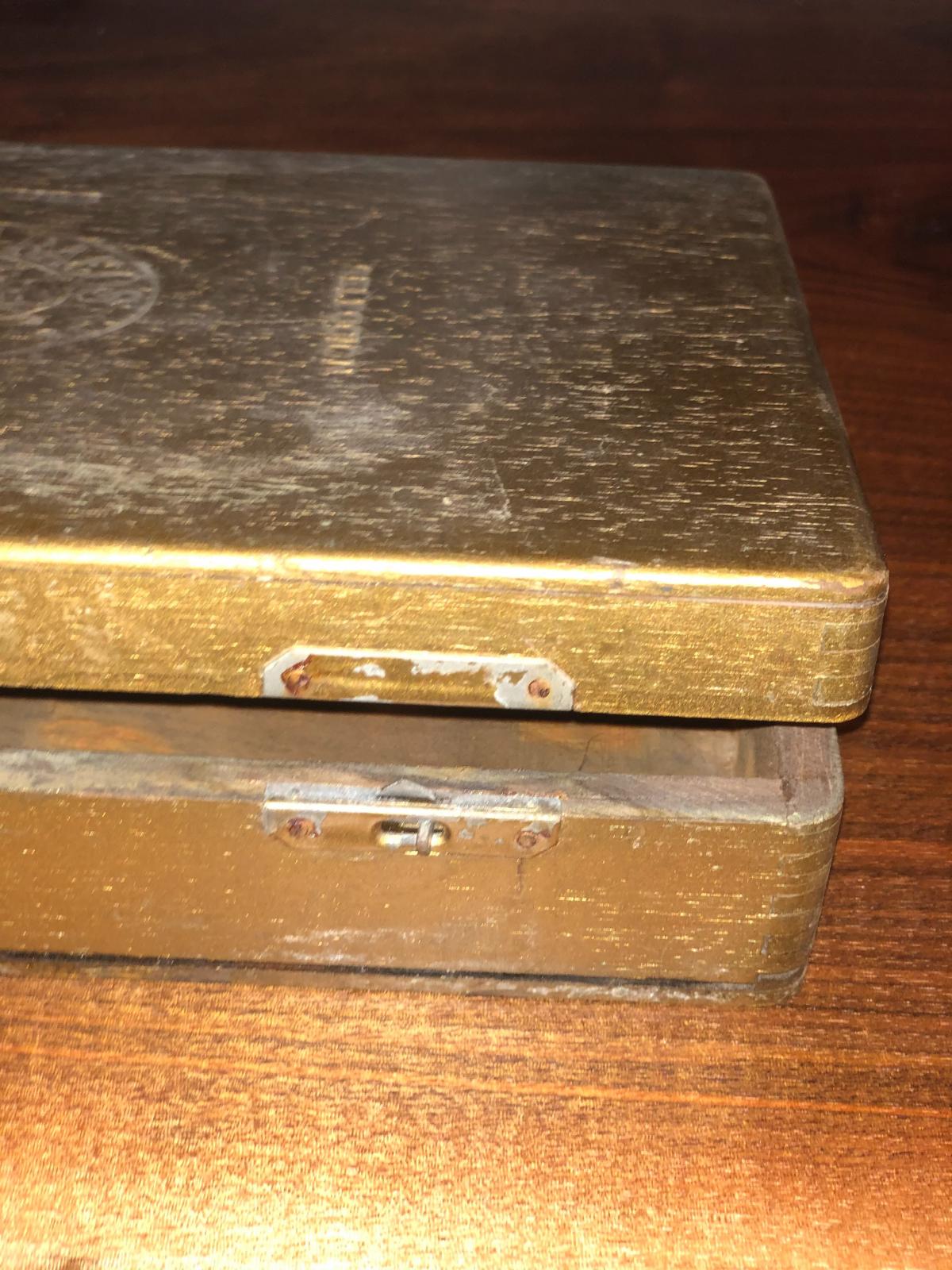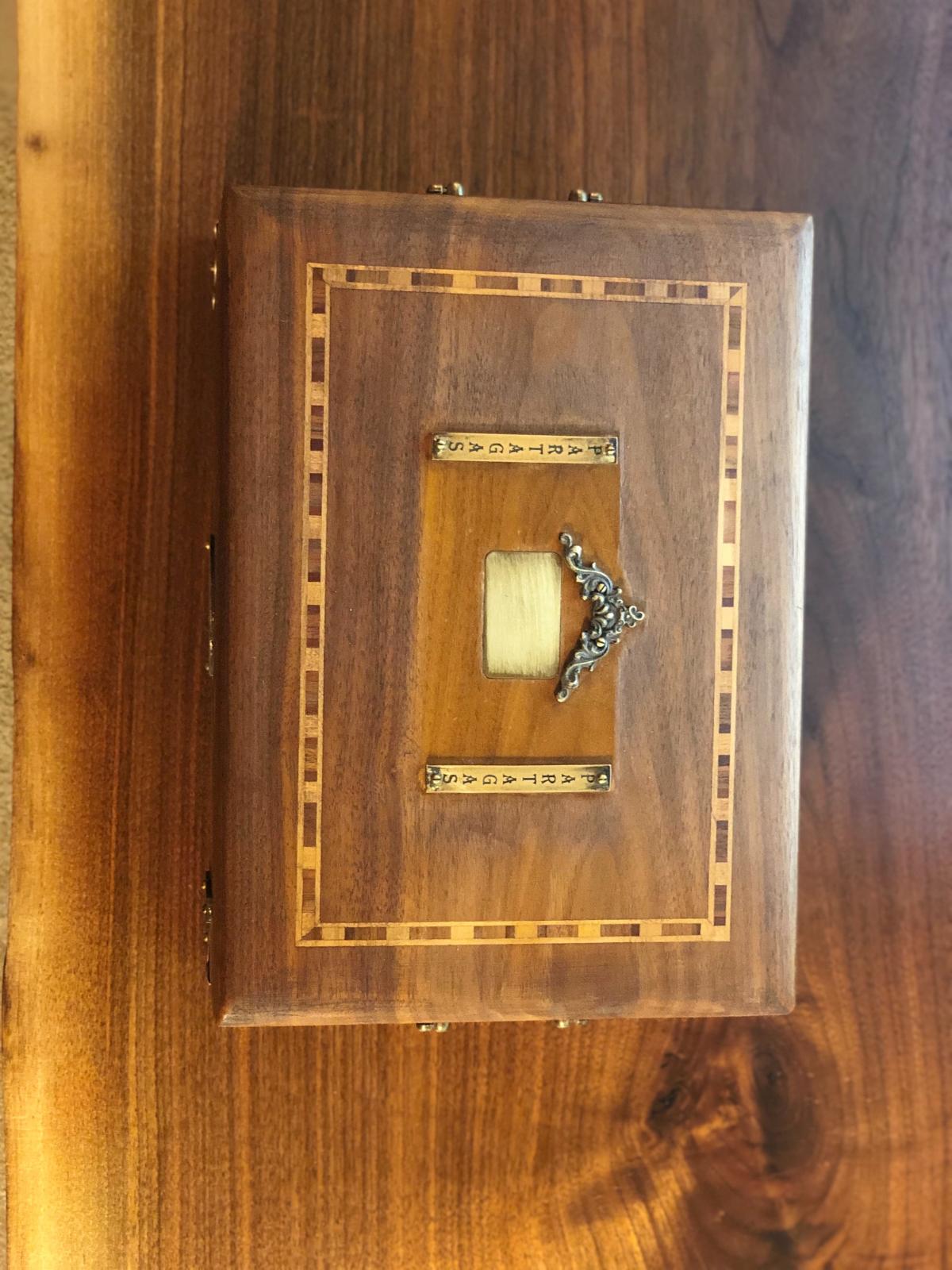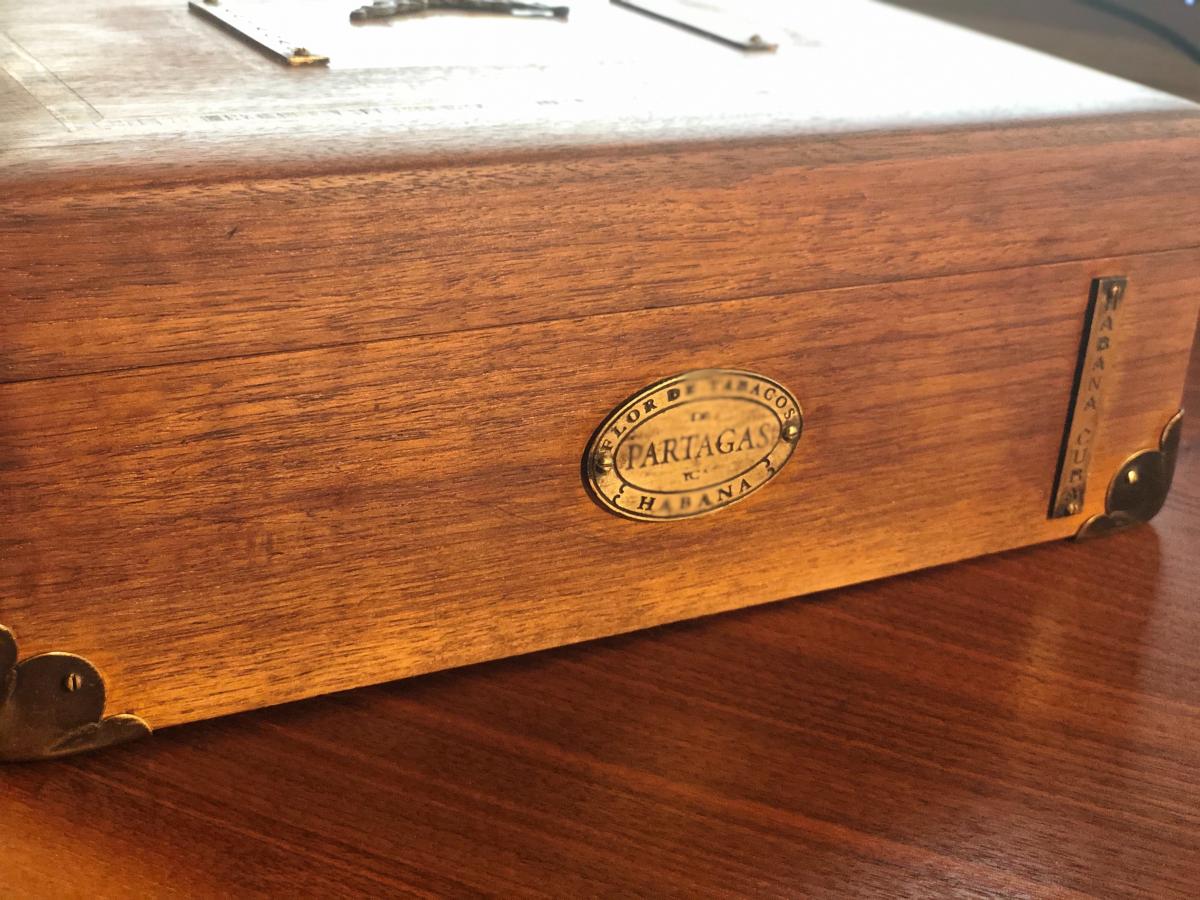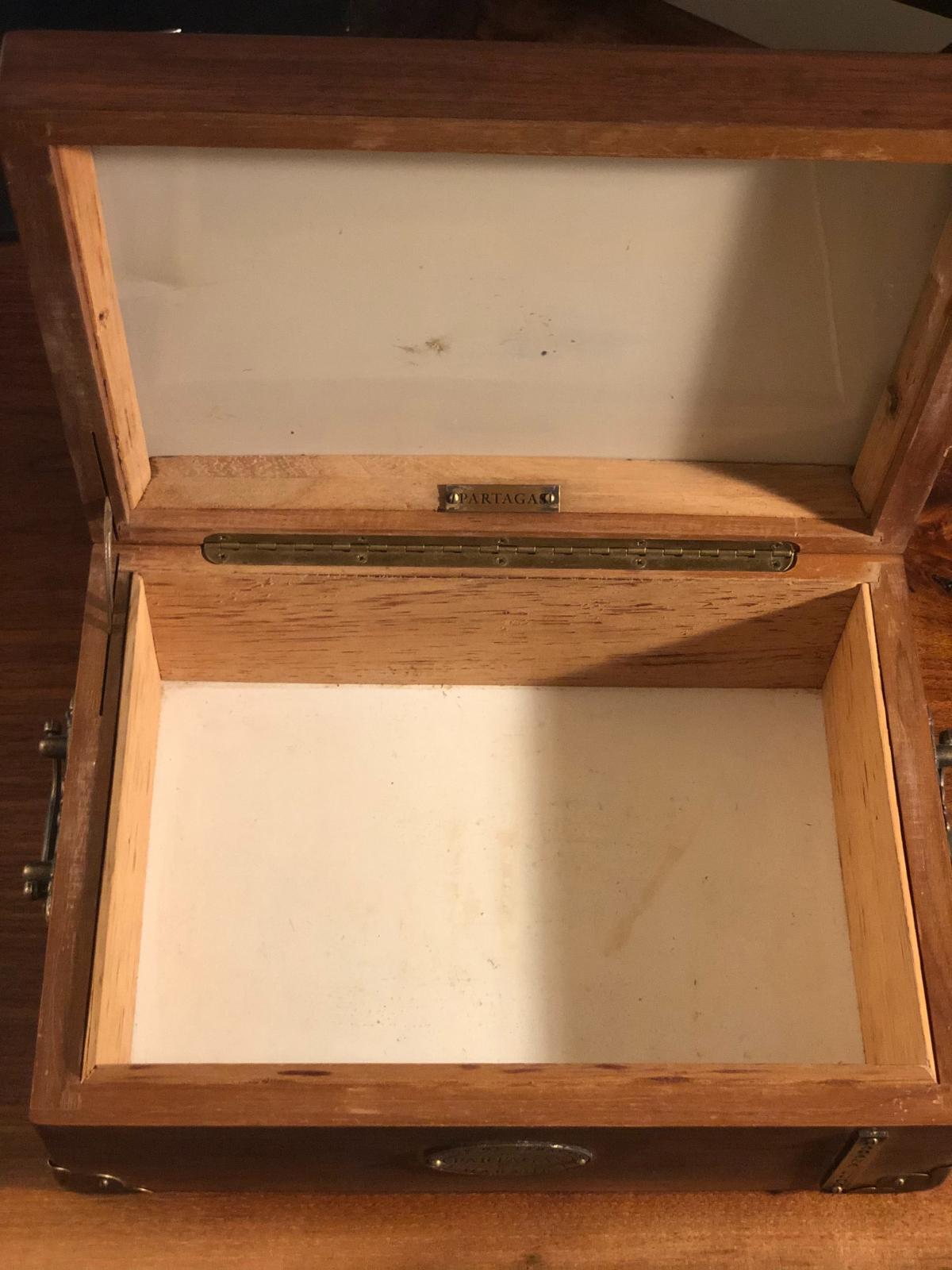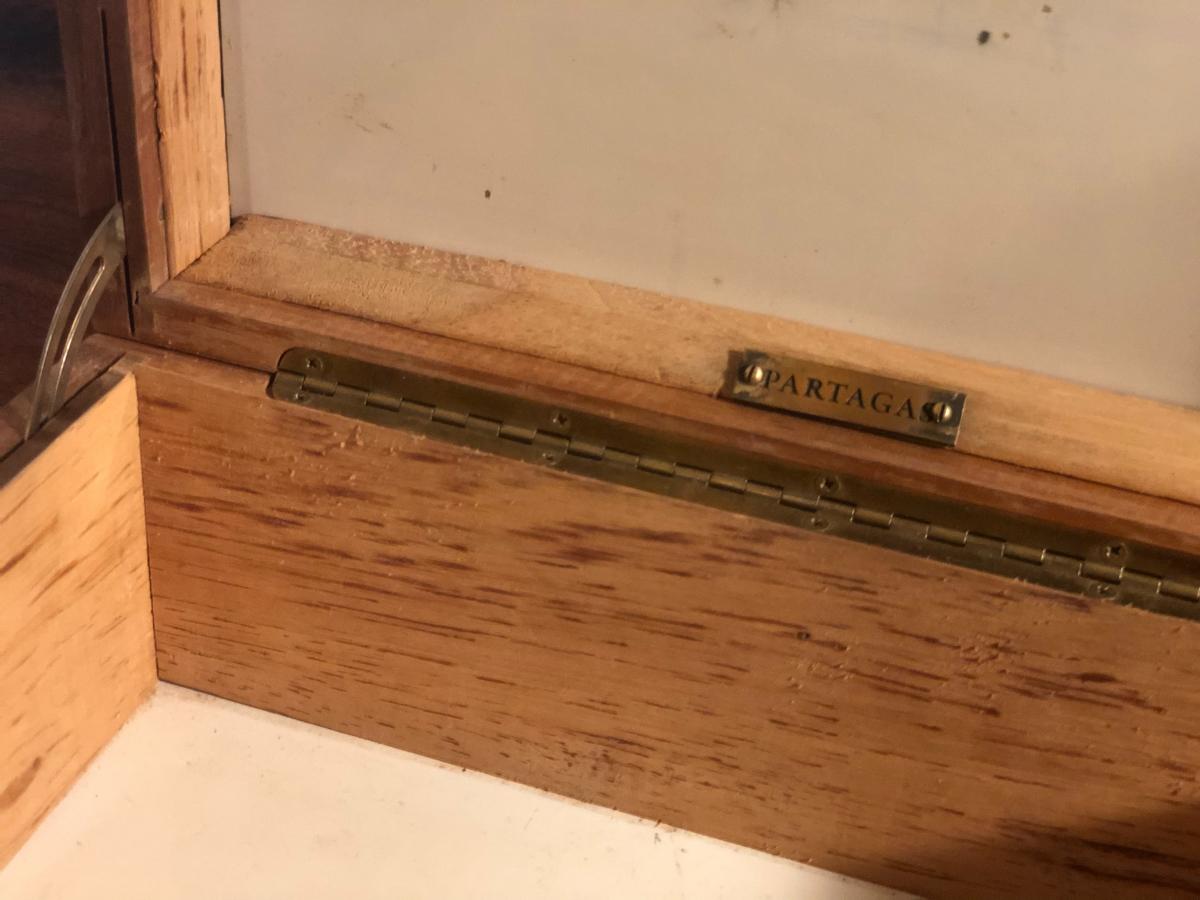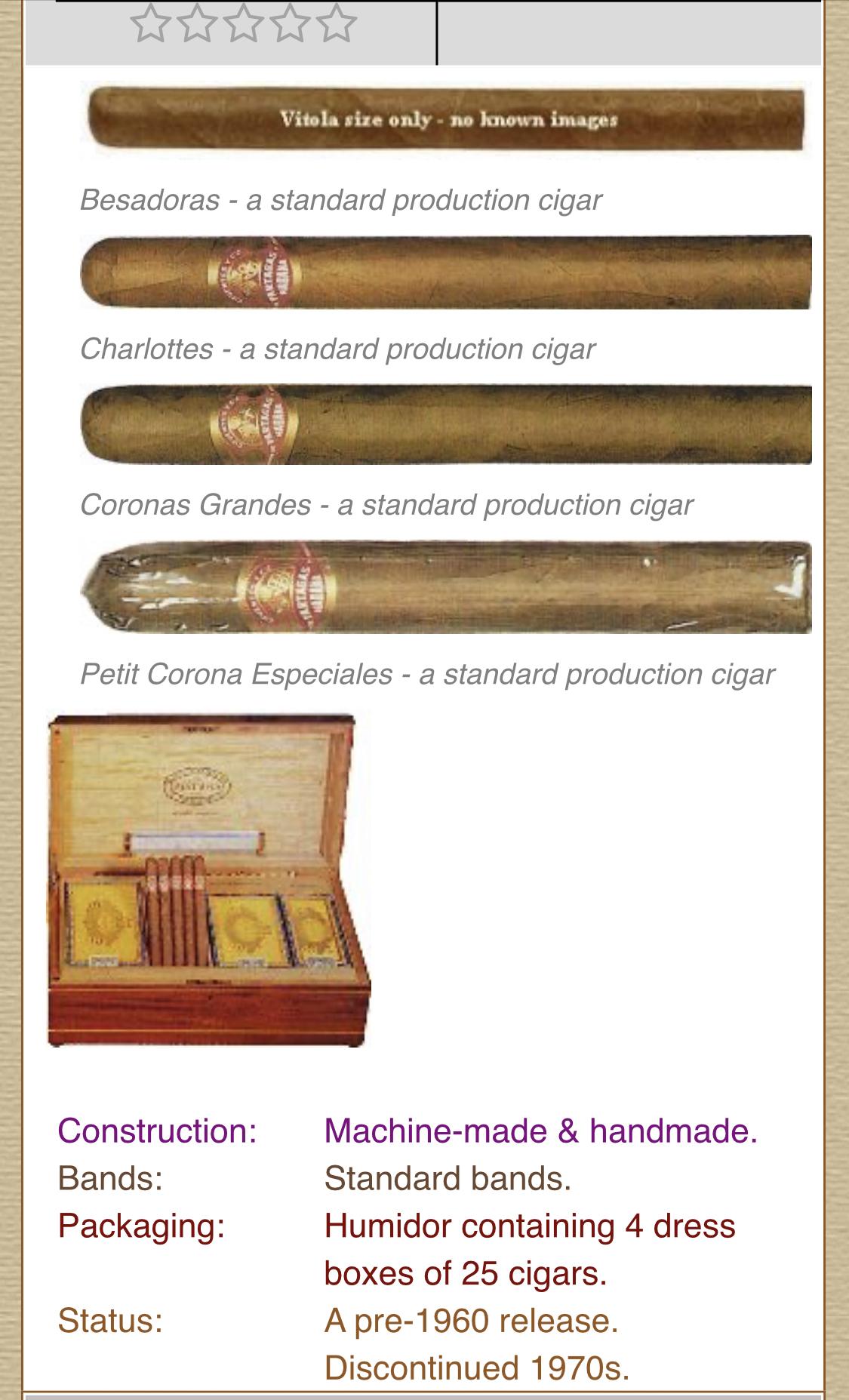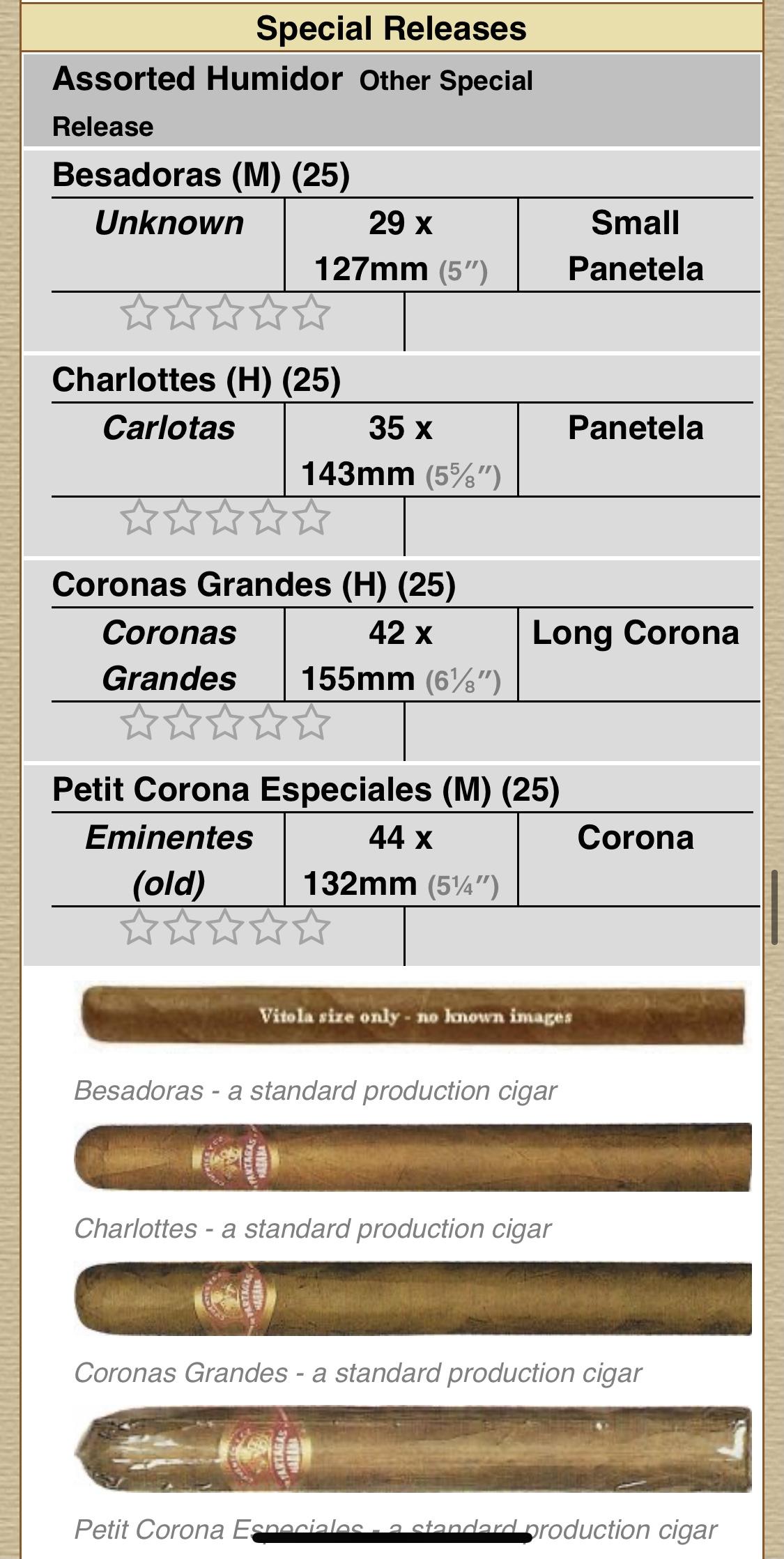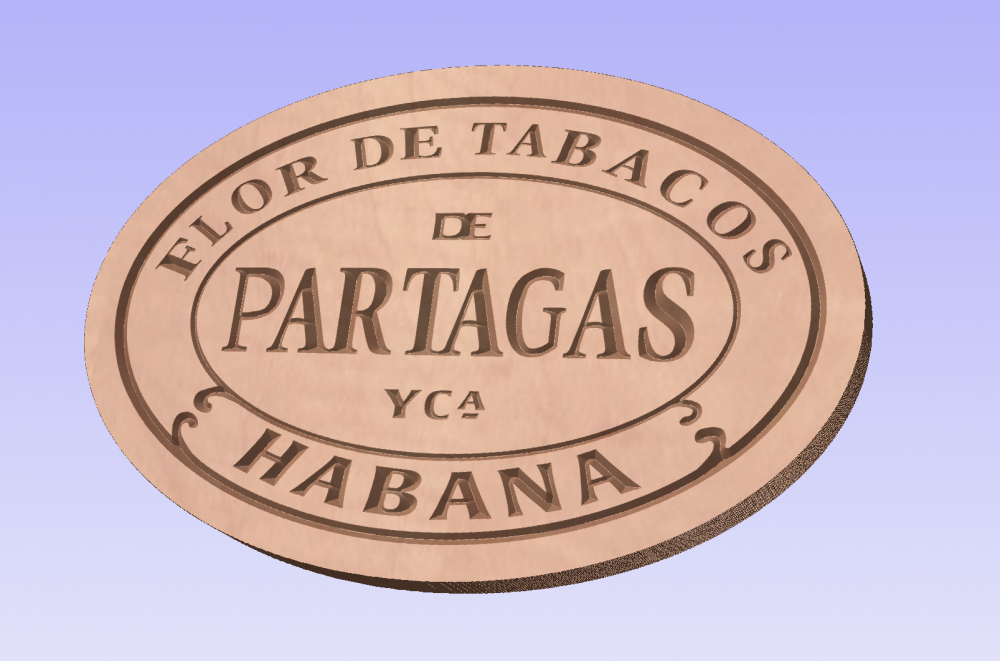Search the Community
Showing results for tags 'HUMIDORS'.
-
Hi friends, I’m back for another thread, to track the build process of my next humidor. Some of you might have followed one of my first projects here: The Wheezydor. I assumed that I’d “pace myself” on 24:24, etc. but that didn’t work out very well. As you can see, I built a total of 4 desktop humidors, plus the Wheezydor, but all are 100% capacity. Zero airflow as well. Soooo...I’m embarking on the Wheezycab, a larger standalone cabinet to load balance the current humis, and to also reclaim desktop space in my home office. I’ll be updating this thread over the coming weeks. If you like this stuff, I hope you enjoy the process. First, a pic of the current state of affairs...
-
Got the Newair x Boveda 500 humidor. Pros: Seals good as usual, good storage space unless you’re stacking in sticks, built in storage for Boveda packs, thoughtful insight into the build of the shelves for storage. Price, weight, construction. Fans are quiet. Cons: it has 1 display which only displays the temperature you wish you keep it at. It is not opti-thermal and instead uses a compressor. Cooling only no heating ( which is fine for me ). Boveda storage is great, however it takes up space for almost every shelf so you can only stack single sticks 2-3 high depending on ring gauge unless they are shorter sticks. Probably not the best for boxes ( I have not tested this but this is an assumption based off Boveda storage locations ). Only comes with a stainless door, no all black. No hygrometer or digital display for it. I’ll rate this 7/10. Satisfied. Newair and Boveda claim that it does not need seasoned, however even with me seasoning it- it still took several weeks to level out.
-
- cigar storage
- newair wineador
-
(and 1 more)
Tagged with:
-
Hello my friends. I understand many of you build humidors on this platform. It would appear (to me at least) that what these people sell as a working humidor does not actually work. I hate to be so blunt, but there you have it! It is also the source of the most common questions that I am asked about in correspondence. I just received yet another one this AM... I know many of you are happy with your products and purchase of these, so for you simply ignore what I am going to ask. Operation of a humidor is in the eye of the beholder, I get that. I am curious however. Many of you know that I convert wine coolers to humidors as a boutique business. And these, working or not are very popular. So if I told you to trash the beads and all the guesswork in converting one of these, what would it be worth to you to get a project that actually worked? Yes, this is a money question. You see, I have never thought of these as a viable humidor, but honestly I have never bothered to try and convert one. Development costs me time and money and neither in my case are unlimited. If I sold a kit for one of these, one that really worked that I could prove within a reasonable tolerance, would any of you be interested in buying it? And lastly, what would it be worth? There is no right or wrong answer. I believe that I can develop this into a platform that can work within the realm of what performance a TE cooler can deliver. Will it work in my shop at 90F? No way, well, I doubt it. But will it work at ambients below 80F? Maybe, maybe high 70's... I don't know. But the parts and the system cost money. And my development time and the cost of the materials including the cooler, something that I have no real interest in building for myself are real. So what say you? Thanks for helping me out... and don't be embarrassed to post. If it working is only worth $100.00 put it down. I want to know. If the concuss is that I can make money at it and get you guys that are log jammed happy it might be worth it for me to take the project on. Cheers! -Piggy
- 31 replies
-
- 1
-

-
- cigarclimatology
- pigfish
-
(and 3 more)
Tagged with:
-
Hello all, I’m an avid cuban smoker but in my college days I was obsessed with woodworking. Naturally, elaborate wood humidors are exciting to me, I love marquetry and anything made out of a nice walnut or other hardwood. The below is my current smoking humidor. Side note, the monte especial 2’s seem to be great in recent years. Anyways, I hunted down some other humidors and boxes that looked interesting and was wondering if anyone would be able to find a bit more context than I could. The first humidor looked similar to the discontinued “Assorted Humidor”: The construction is solid, and truthfully my hope is to refinish this as it looks like someone started that but didn’t bother to remove the hardware. Then I’m aiming to fill it with some comparable current production partagas vitolas, mirroring whatever was in here originally as much as possible. This might not be the assorted humidor though, so correct me if I’m wrong. The second nature box that I recently found seems much earlier and I couldn’t find anything about it online. The text is a bit faded but the one that is most difficult to make out seemed like the vitola: "50 portuondos". Any information or guesses would be great, appreciate the knowledge you all bring to the table.
-
Hey all. A wife of a friend of mine wants to get him a good desktop humidor of at least 100 count. This guy likes the finer things in life and so cost is not a huge issue. I don't mean unlimited but more than the 50-100$ desktops on Amazon is no issue. Having written that, if you know of a really good quality one that looks sharp and doesn't break the bank, that is also good! Cheers! B
-
So I am not a 'fan' of the Oust Fan! However there are a number of people who don't have automated systems who would still like an automated timed fan that can push a hefty amount of air and water around inside their humidor. Seeing it is a holiday weekend, I decided to prototype such a device, and here it is! I purchased a couple of these programable timer modules about 6-8 months ago and have wondered just how good they are and what their mean-time to failure was. So I set one of them up to run a fan on a bench in the lab, 4 seconds run time, 4 seconds off time. The damn thing has been running almost non-stop for over 6 months now. The setup: Wood pattern PVC box that I port in the shop. This one has a ball bearing, long life 23CFM 60mm fan, tobacco plant grill guard, programmable timer, lever nut (EZ connect wire connectors) and some silicone rubber feet for the bottom. It is completely wired inside the box (the timer is in there as well). Plug in the wires to a 12VDC power supply (maybe an old router/cordless vacuum power supply) and you are off and running. I don't have literature on the timer, but it has a nonvolatile memory and runs off 12VDC just like the fan. You plug in a 12VDC power supply and off it goes. I figure running one 30 seconds out of 300 seconds is just perfect. Of course you can select just about any time you want. Cheers! -Piggy
-
Hi all, I've searched this but haven't seen a good thread discussing, so figured I'd post. My accumulation/aging of cigars started 7+ years ago with NC's, and I transitioned to CC's 5 years ago. Like many here, I graduated from a 200 count desktop humi to a coolidor, then a larger coolidor, then a 150qt coolidor with custom cedar shelves. That filled up, and eventually I discovered Sterilite air tight tupperware. I now have 7 of the 54 QT tupperwares in my basement, and they are excellent at holding humidity, and cheap. It has been my daydream to one day have a great smoking room in my house with a nice large storage solution for all my boxes. I finally have that chance, as I've purchased a larger house and will be moving next month. What I'd like is a storage solution big enough to accommodate my 200+ boxes, as well as extra capacity to hold at least another 100 more... because you know.. cigars are a great investment I've looked at Aristocrat Cabinets, have read some of the threads about wineadors, and have seen some folks converting commercial sliding door beverage refrigerators into cigar storage. What is the consensus on the best option for storage of 200+ boxes? At what point is it silly to spend $3k+ on an Aristocrat, when I could start considering building a two-walled corner "mini walk-in" storage area into the corner of a room in my house. Is there a readily available commercial option for a sliding-door beverage type cooler? I love USA's Cigar.land thread where he shares his massive collection, and I drew inspiration from some of his storage solutions: But I haven't seen anything like these available in the US: Would appreciate people's ideas and input on the best solution. Thanks
-
Understanding "Activation Logic" I get more and more questions regarding humidor controllers and what separates the various controllers on the market. This has been written to introduce the readership to what makes a humidor controller tick and how this programming characteristic affects the life of your cigars in your custom humidor. Understanding the difference and the jargon of logic controllers is the key to getting the system performance that the advanced humidor builder requires. This thread will discuss some of that control jargon so that you as a humidor builder or consumer may have a greater understanding of the controls that you will build into, or have built into your humidor. There is a lot to be said about what humidor control system is the best. System controls are like other forms of technology; they represent a series of trade offs. Best, does not mean the same thing for all customers. The controller world consists of compromises; those include the cost, features, and simplicity verses effectiveness. You cannot roll 6.5 on a six-sided die! Facets represent complexity. Complexity generally represents resolution, precision, utility and in some cases the difference between success and failure. Lets start with a few basics. A huge problem with active humidor controls is that most people don't know what they want or need. They see the controller as a switch and little more than that. Complicate that with the fact that most “prepackaged solutions” do not deliver anything but the crudest of switching controls and you could have making of a problem instead of a solution. The “crude” nature of some of these control products can be considered a blessing or a curse depending on your perspective. It is a blessing if you are happy trusting and not really knowing how your humidor performs. That blessing is typically dressed as operator simplicity. It is a curse if you are interested in demonstrating the highest performance of your active controlled humidor. That simplicity, can very well cost you the high degree of precision necessary to make small automated humidors as good as they could be. So what system is best? The actual answer has little to do with controls at all. The best system is the one that works for you where the cost represents a value to you. As in many cases here, I ask you to ask yourself; what you want to control and why, and certainly how much money are you willing to spend to get you there? I have adopted this view myself. While I am somewhat obsessed with precision control, it was the search for reasonably priced precision controls that has brought me to where I am at today. Spending thousands on controls was not an option. I have used several types of controllers over the years. As it is my desire to build the best humidors that I can build, that desire has driven me to look for better solutions than the current crop of “off the shelf” humidor controllers while still being competitive with them. Not all systems are equal, neither are all controllers. An excellent controller is at the heart of an excellent system. However, an excellent controller does not make up for bad humidor design. And on the flip side, good design will not compensate for a poor controller. Design and control must work symbiotically to build the best humidor. As a consumer you have to judge the trade-offs for yourself. The trade offs start with costs. So, what do you get with your controller dollar? Here are some pertinent points. Simplicity! I think this is important to a lot of people. It is not really important to me. I would encourage those looking for controllers not to stress simplicity. I have a number of controllers and while the package on some are really nice, there are a number of problems that these controllers cause… cause, rather than fix. The nice package is useless unless it works! A controller should fix problems, not cause them. I have presented my control problems to some of these controls companies in researching controller technology. Unfortunately the answers to my questions have typically been, “we sell what we sell” or “this is what works well for us.” In other words, “We can’t help you!” As a means to fix my problems I worked through various physical modifications to my systems. I use my own switching logic and had limited success. The lesson here is this. What started out extremely simple became complex because I could not perform the function that I wished to perform based on the parameters that I wished to control. All controllers have limitations, but many of these “easy learning curve models” quickly lost their simplicity when they began complicate my projects as a means to overcome their limited utility. Along with simplicity is design. Design includes everything from size to programming. This is where a superior controller shines and where preconfigured, keep it simple stupid controllers lose their luster. To keep it simple, a typical controller works around a set point, well, one set point, and two additional "logic" points. This set point, logic points system, has to be considered typical in the controls world. What "decisions" the controller makes around the set point is what separates the heifers from the bulls. The "logic" of when to perform a given function is programmed into all these controllers somewhere. The main question is, “Who supplies the logic?” Unless you have experience with controllers, you might never know about the importance of activation logic. Ultimately, the control over the set point is at the heart of a great controller. The ability to choose your activation logic is at the heart of the best controllers. For the sake of clarity and example, let me describe the process of a controller product that I own and have tested and describe how the process affects a humidor. This is one of the easy-to-use controllers that I tested in the past. Most if not all controllers will work around a Set Point. The first thing that must be established is whether the controller recognizes the set point as a high set point or a low set point. This is not a minor distinction and must be considered as a part of the activation logic matrix. Many controllers are programmed with firmware that will determine this for you, making it simple. This is a prime example of why simple is not best. Simple means that if you don't like the way the controller functions, you live with it or throw it out and try something else. If you are cleaver perhaps you can even find a workaround. Flexibility is far more important to a humidor builder than simplicity. Flexible set points and their associated activation/differential logic points are the single most important aspects of good humidor performance when viewed from a controls perspective. I will explain more about this going forward. The set point then, in some cases, does one thing only, and the manufacturer of the controller (or the programmer) will dictate it to you. You see, you can change the set point, but you cannot typically alter the functioning of the controller around the set point with these preconfigured units. The actual trigger points (activation logic) are firmware programmed by the manufacturer. They do this so the controller is simple to use and for other reasons. One “other reason” is so you don't foul up the function of logic of the controller by not understanding its functions. Simplicity is great for the novice... for the advanced humidor builder it is a roadblock to a better working humidor! Simplicity assumes that you are a moron or you are lazy, not capable of managing advanced control options. As a consumer, you have to decide whether superior control is worth the steeper learning curve. I have outgrown “preconfigured” controllers. Anyone interested in exceptional humidor performance outgrows these packaged controllers very quickly. Or, they just don't concern themselves with the actual operation of their systems! Now on to the example. This controller has a set point of 70 dF. You can choose your own set point and it does not have to be 70 dF, I am just using 70 for the sake of the example. As the environment temperature increase, the controller will switch on your refrigeration. We will define this as a High Temperature set point. Ask yourself this. How does the system determine when to start and when to stop an appliance, my cooler for example? My experience with this one type of prepackaged unit (my example) is this first activation logic number is 1 dF above the set point. 71 dF then is the Activation Logic point. Systems don't react instantly. Remember this is real life, not a simulation. The refrigeration begins to cool the coil and the coil in turn starts to slowly cool the environment. How your controller sees the environment is just part of it. More important is what decisions it will make to change your environment and when it will make them. In our example, the cooling coil continues to run as the system slowly declines in temperature. The cooling coil almost certainly cools below the dew point eventually, and this can take seconds or minutes depending on your cooling system. At or near the dew point the cooling system starts to remove water from your humidor. You see the air conducts heat and transfers it to the cooling coil in order to cool your humidor. That same air contains the water vapor that makes up your relative humidity and that water passes by the cooling coil as well, but in the case of water vapor, it does not just pass by it like the air does. It collects there as condensation and turns to liquid water and either freezes there or drips off your cooling coil. The longer the system runs, the more the air gets cooled and at the same time, the more water gets removed. So lets say that your humidor finally gets to the point where it shuts off, and in the case of the prepackaged controller in my example, the temperature is now down to 69 dF. This point is termed the Differential Logic point. We have now defined three points; the Set Point, the Activation Logic point, and the Differential logic point. Now back to the example. Lets just say that the system has taken about 15 minutes to get from the activation logic point to the differential logic point. The problem; the controller, even with the humidifier running, has run down the rH in your humidor to about 40 rH. I am not postulating here. I know all this because I have built and tested active climate control humidors for many years now. Empirical evidence has shown me, that the longer a system runs and takes to cool, the dryer the system will be at the end of the cycle. So this controller has done its job. It turned on a cooler to cool the system and it cooled the system! When the system got dry it turned on the humidifier to put water back in the system as well. However, as a result of poor logic control, it has also caused a sufficient drop in rH in a humidor to drive the humidifier for another 5 to 10 minutes to bring the humidor back to your rH set point. Imagine what your humidor environment is like if it is 80 dF in your office, and your humidor is running once every 30 minutes. 15 minutes to cool, rH down to 40 in the cooling process, another 10 minutes to bring the system back to 60 rH and the whole cycle starts again once the temperature creeps back up from 69 to 71. Is this what you want or expect? In this example, you no longer have a stable environment. You have a controlled environment, yes, but stability is not a part of it. Now imagine a controller that you can program yourself to change the activation and differential logic. Do you think that you could change this cycle and the problems that have resulted because of it? I use an industrial process controller that I program myself adapted for use in a humidor. This is not a fancy gimmicky thing that has logos of smoking cigars on it. It is a straightforward mini computer control for reading sensors and controlling a system based on those sensors. It is what industrial users are using to control cold rooms, commercial food production spaces and the like. You see the people working with industrial controls don't want a controller that decides how to control their environments. They already know how they want their environments controlled; they just don't want to post a guy looking at the parameters with switches in hand ready to control them. Instead they use an industrial process controller, a logic controller, for that kind of work. This is what I use! They perform the same functions as the simple humidor controller; they just perform it better because you have a greater command over more of the control parameters. What makes a good controller a great controller is the ability to adjust it to your situation. Simplicity is a mindset and is a function of the operator's learning curve and nothing more. The ability to control the logic of a system is more important than how simple it is to set up. That is my opinion. I have a lot of evidence to back it up by the way! Lets take a look at the way a programmable logic controller behaves now and how it works. First we choose a set point as before. Lets say it is again 70 dF again. I have more choices to make, however. I have to decide on a set point differential. Unlike the factory set controller in the example above, I will choose for the sake of this exercise 1 dF. If you could control it, the set point differential on the previous example above would be 2 dF. Do you have to choose 1 dF? No you don’t. You can choose any number of points dependent on who makes the controller, 0.1 to 179 (for my controllers anyway)... Frankly, anything under 1.0 is not really practical but you can experiment with any setting you want, that is the beauty of a logic controller. After the set point differential one defines the activation logic and the differential logic points. Just as a reminder, these are the "turn on" and the "turn off" points. The set point is just a reference point. The set point differential is the maximum spread between the activation logic and differential logic points, just for clarification. With these four settings under our command we have control of not only where the set point is, but the logic that the controller will use with it to turn on and off the system appliances down to as little as 0.1 degree of resolution. If we work backwards to determine the activation logic of our previous example it would look something like this. The set point would be 70 dF, the set point differential would be 2 dF. The activation logic and the differential logic would be 50% and <100%> of the set point differential respectively. Going forward, since I don't want to lose you in programming details, I will only look at the final result. In my case I will choose an activation logic number that will activate my controller to start when the temperature is 70.1 dF. What is more I will set the differential logic to shut the cooling system down at say 69.6. With the flexibility of the set point differential system with activation logic, there are actually many parameters that one can use to get the same result. As you can see there are many advantages to a system that allows you this broader range of control. As systems get more complex, such as using cooling to dehumidify the range of control afforded by these systems become absolutely necessary. In this example alone, you can see that I have much greater degree of control over my humidor. I am no longer stuck with the crude low resolution of a preconfigured instrument. I have the freedom to control the logic and choose various points above and below the set point to initiate and cancel my control cycle. What is more, I have the same flexibility for all the appliances that are attached to my controller. The algorithm for the differential logic system allows you to simply change the set point, just like the preconfigured unit and retain the same differential activation and deactivation points, again just like the preconfigured system. Additionally however, you can simply broaden the scope by changing the set point differential, or reprogramming the activation logic and differential logic numbers together or separately to gain a whole new degree of control outside of that provided by the prepackaged controller. You have the same range of control with any of the digital outputs and they easily program all the same way. You want better control of you humidifier... you got it. Want to experiment, you can! You can have the controller, working off the set points and the differential points turn on and off appliances just about anywhere that suits you! Of course, if you don't know what you are doing, you can confuse the controller!!! You can tell it you want heating and cooling at the same time for example, and it will do exactly what you told it to do!!! Assuming you have a heater and a cooler, it will run them both! This comes in pretty handy actually. You can for example, run the cooler briefly to dry the humidor if you live in a high humidity environment, and then run a heater to bring the temp back to were you want it. Humidor in a damp basement, live in the humid south, not a problem? What can you control with a logic controller? Most of these preconfigured units have only two control points, two preconfigured digital outputs. One point controls refrigeration and the other low humidity. What if high humidity is your problem? You are stuck! Not with a logic controller. Want more function? How about a real time clock that can shut your system down while you are in your office so it does not distract you? How about a timer for timed circulation? Need more options than just controlling low humidity and high temperature? Want to control a cooler, heater, humidifier, and a dehumidifier??? With the right controller, you can do many things that the preconfigured models cannot. Want to build a project humidor? There is only one choice as far as I am concerned. If you really want a flexible controller that works and will fit your project and your needs as they develop, the right logic controller is the best choice. The picture shows a couple of my controllers mounted in faceplates. The controller itself is a small package, separate of the faceplates and the enclosures. The lighter is a DuPont Extend that I put in there for size reference purposes. If you have questions regarding digital humidor controls I am happy to field your questions on or off the board. Happy building! -Piggy
- 18 replies
-
- 2
-

-
- Humidors
- controllers
-
(and 6 more)
Tagged with:
-
As many of you know I am always building something new in the shop. Humidor perfection is a goal that I never attain yet always attempt. I had a member contact me about humidors the other day (noting new about that) but he wanted to see some of what is entailed in a CigarClimatology humidor. Here is a brief glimpse into Piggy's lair and a sneak peak at a new Gen 12 humidor. Cheers! -Piggy Gen 12 Humidor Build Tour
- 21 replies
-
- 5
-

-
- humidors
- wine cooler
-
(and 2 more)
Tagged with:
-
I don’t use any wood in my humidors. However I am tired of adapting different materials to construct the one shelf that I usually use. I have a minimalist approach to shelving. The more you use, the worse the humidor generally works. Shelves impede airflow. I prototyped a very simple shelf made of robust Spanish cedar. I wood carved a couple of members however they are so narrow that the carving was less than desired so I decided to embellish the last member with some Habanos cab “brands.” Brands as in branded or embossed brands… the ones that come off the tops of cabinet lids. These take some time to recreate. I have searched high and low for matching fonts, but they are not easy to come by. Some used are similar, some totally recreated by me. Anyway, here is a rendering of my first attempt. I have several I am going to recreate (just for kicks). Criticism welcome. Enjoy! -the Pig
-
That’s right folks, you heard it right. Apparently we have some NASA scientists on the board, obviously displaced by cuts to the agency just itching to team with me to create the perfect humidor. Today, early in the AM, I receive this transforming email from a guy, no a scientist, a hidden jewel amongst us plebes regarding a business proposition to create the perfect humidor. The question is should I take it??? It is obvious that I have impressed him with my knowledge, charm, whit (and of course good looks). My fortune has got me teary eyed… Here is the letter and proposition: Ray, Apologize that you regurgitate third grade physics to your bof (birds of feather). It must get tiring; and plagiarizing always sucks (technical term). Introduction- my name is Brian and want to combine my (education) and proven designs to re-position logic to solve your need for a perfect environment. Perfect environment... Yes, I worked at NASA for many years and want to take some NASA research on microfluidic bubbles from GRiD Compass (and a unknown fact - using MF for heating/cooling in sealed spaces) with MF surfaces with tolerances sub .01° at 303K. Granted that was extreme, as lives were at stake. Take our technology and combine with your experience with sensors/actuators/thermodynamics to solve something that keeps you up all night. Reduce costs/complexity, create small form factor, add to existing and future units. End result. Profit Prototype, Patent, Optional Next Steps Review idea, let me know your intention, will send some non-compete, and IP legal forms. Have a great day! b So I have to bring it to my brothers here first… The confidentiality agreements alone would cause me to have to give up my posting here. There would be no more explaining of humidors and desiccants (yes, I can hear you clapping all the way over here… -LOL) No more pseudo-scientific methods and ideas, no more fun and games, even the use of a pseudonym would have me hunted down by the legal dogs… There may be a Knighthood in it for me! Bill and Melinda, move over… "I don’t want your jet so close to mine kinda’ stuff!!!" No more Milwaukee power tools for me. It would be Hilti or Festool!!! -LOL FoH or this? What say you, should I take the deal??? -the Pig
-
There is a lot in the analysis of humidor performance based on how you look at data. Take this case in point. I often look at raw data from my data loggers in a highly compressed, macro perspective. While this view can leave you, will leave you, without much in the way of detail, it will help you espy trends and shifts, and even corrections needed to your system. Here is the first data log. Now I data log this test box everyday, unless I forget to download the logger and reset it. I test a lot of stuff in this box. I house a few boxes of cigars in here plus my frauds collection. The cigars just take up space as I use the humidor for some overflow and to park cigars while I move them around, or have no other place to put them. This is a 'working' humidor, tuned to work in the real world and not tuned to find utopian results. This humidor works in my shop, not in my home and I keep cigars in it even when the temps in the shop exceed 90˚F. If you look at the data streams, the data is so compressed that it gives you an overwhelming sense of the highs and lows, the extremes, while obscuring the data in between the highs and lows. One of my clients needed a low profile humidifier and I chose this box to test it. What I have not liked about how this humidifier works in this cooler, is the deep low-end extreme values that the humidifier produced in this cooler. It is important to note, that at my level, sometimes the slightest change in your humidor design will produce profound effects. This is one such case. So what I did here is to replace my standard 26CFM fan with a 36CFM fan. I wanted to match the rate at which the cooling would strip water from the humidor with a humidifier that would meet or match that rate when the humidifier was operating. Now, this philosophy is not without risk. You can overshoot your system parameter when you use the approach, and empirical testing is the only means to determine if you have succeeded! Here is the micro look at what these cooling cycles look like. You can clearly see the system cool and the humidifier compensating for the loss of humidor water as the system cools. This is one logger, logged through my controller sensor so it is time aligned. The deep rH cycles are of course the result of cooling cycles, some of which can be cured by tuning the activation logic. Since this logic approach will ultimately affect the way the humidor as a hole runs, and I could 'tune it' for a specific result, I deliberately chose not to do so here. Like I said, I generally 'tune' humidors to run in the real world, not to provide limited 'perfection' to post about. I could tweak this thing to look damn good on the logger but that is not my point nor my goal. A robust working humidor is my ultimate goal. There are a lot of factors that go into making decisions about this "robust working humidor" philosophy. None of which I am going to cover here. I just wanted to say, if I was hell bent on tweaking this for a 'better log,' I could do it, but would consider it cheating! Here is what happened when I changed the fan... Wow! What you can see here is the rapid rate of hydration that the new fan provides. For now, I will call this one a success. Of course there may be lurking a specter of overshoot if the right conditions are met. Now I have studied the cooler function now for several days and I don't think it is going to happen, but it still could under the right circumstances. Lets look finally at the micro view. It too is very telling. One of the keys to knowing that I have succeeded here is in seeing that the initial running of the humidifier during cooling actually is halted by programming, it is overpowering at this stage, as it overproduces water initially, requiring a shutdown and restart. Look at the chart and you will see it all. ... now a little activation logic tweak... maybe. -LOL It never ends...! That another day! Thanks for reading! Prof. Piggy
- 3 replies
-
- data logging
- humidors
- (and 6 more)
-
There has been considerable talk in the Humidor forum as of late regarding the “dehydration process.” In a recent topic about a walk-in humidor project it was mentioned as a recommendation by a tobacconist that a new walk-in be built without sealing it, assuming that the exterior ambient would provide sufficient diffusion of water so that no dehydration process would be necessary. It was at least implied, as I read it, that without leakage and transfer of water to the outside environment, the humidor would over hydrate. That ‘leaving the door open’ or leakage to the outside macroclimate would solve the problem. I find it interesting that dehydration is rarely a topic of humidor study unless I bring it up! In talking to a lot of smokers looking to solve humidor problems, I find it one of the main reasons a cigar enthusiast contacts me. It does appear, at least to me, that this important topic is all but ignored by the mainstream community and humidor builder alike. It would appear also, that many of the folks that I speak with have some sort of issue with high rH. It also appears, that most folks live with it rather than deal with it… While I am not going to bore you with an in-depth discussion of how I solve the problem, I do find it an interesting topic. After studying hundreds of charts of humidor performance, I thought I would parse down yet another chart of one of my humidors to show how I deal with the issue. Of course you need the proper appliances and controls to meet the foe of over-hydration in order to beat it down! I use refrigeration to perform the task, as there is little that strips water from space like a cold plate that is at or below the dew point. Chart A shows an overall view of the process. The chart shows one of my humidors at work in my lab at about 3am. For the record the outside conditions are such that the heater is running in the humidor to keep the temperature up. This has little actual effect on the process itself, but it does act to keep the temperature in the range that I wish to store. Repeated dehydration cycles when the ambient is below the storage set point would eventually decrease the heat and temperature in the humidor over time. This is off topic! Chart B be gives you an idea about how a sealed humidor will act at a low temperature and the duration of the natural cycle of a sealed humidor to over saturate itself with water if left to its own devices. As you can see, it takes 9 to 10 minutes to move from a low-end rH condition to a high-end rH condition in this particular ambient set of conditions. Chart C shows some of the dehydration process and the duration of the dehydration cycle. The dehydration cycle itself runs about a minute and a half. It should be noted that most processes in humidors overshoot their run times. Knowing how to deal with this is learned empirically and learning how to produce desired results is borne out of experience. There is no handbook for it! Only testing and experimentation will yield these kinds of results. Knowing when, how and how long to run appliances is as much art as science. The two square-wave signals are generated by my appliances to track their performance. What you see here is the time line of these appliances actually switching on and off. Without such data I would simply be guessing at where and what to adjust. I thought it would be interesting to show how precision instrumentation performs to keep my humidor ‘in line’ so I included the signals on the chart. This is ‘inside baseball stuff,’ but I thought it might be informative. If I analyze the chart with my software the actual range for the rH throughout the cycle is only about 1.5rH. A cooling cycle itself will take a greater toll as it is easier to remove water than to cool air but that is another story. In my opinion a sealed humidor with an active (wet) humidifier requires a dehydration cycle to remain within [my] limits. If you were at all interesting in how I came to that conclusion… well… this is how! Thanks for reading! -the Pig
- 16 replies
-
- humidors
- dehydration
-
(and 5 more)
Tagged with:
-
I have begun to delve a little into what I call micro analysis of humidor performance. I can't expect it to really excite anyone but me, but there is a certain amount of pleasure derived from making something work, making it work better and trying achieve perfection. It is interesting to see if an idea that you have will really turn into something that you will consider as a standardized design or whether it is a failure. This is the same humidor on two different days with similar temperatures (outside). My goal was to try to shallow the dehydration during cooling above the 80 dF ambient mark and see if I can decrease the frequency or the amplitude of the cycle. Every improvement must do one or both of those things or it is not an improvement! These are high magnification pics of the humidity oscillation due to refrigeration at a high temperature (ambient outside). Any of these very small dips are acceptable to me, but if I could pull them down to as little as 3 rH I would really be pleased. At 80 dF outside, I don't really think it is possible but it does not stop me from trying! Test A is a native process. Cooling cycle begins and hydration follows. The cooling cycle is run until completion and there is residual drying that initiates subsequent hydration cycles. Pretty straight forward. Test B on the other hand was an idea I had about interrupting the cooling cycle when the system called for hydration and then once the system was hydrated again the cooling cycle would resume. This would drag out the cooling cycle, and perhaps over cool, but it would theoretically reduce the large dips in the rH to smaller ones. In cooler weather the system would be unaffected by the design. I am intrigued as to how it works and if I distort the chart to show the dehydration cycles highly compressed with the amplitudes exaggerated it looks like it does work quite well. I will crop some charts and run some analysis on them to look at the average rH, as well as average highs and lows to be sure. Thanks for following. -R
- 14 replies
-
Some pictures of very fine Humidors sold by one of the Casas del Habano in the city. These are : 70 numbered “Piano” Humidors manufactured by “De Cuba” celebrating Chucho Valdes and containing 20 MC 2 & 18 Cohiba Pir. Extra. 30 numbered “Compay Segundo” Humidors manufactured by “Cedral” containing MC 2, 4, Edmundos and 520. I found these beauties during my first days in town, several are on their way to Europe. Nino For more pictures : http://flyingcigar.d...-fine-humidors/

.png.15b5f6bc4159a73805a9f118f79a68ca.png)

